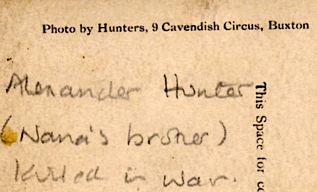| R.F.Hunter Ltd ~ History |
|
|
|
|
Subsequently, further information came from Robin Selby, grandson of Arthur Blackburn & son of Jim Selby. The two accounts have been combined to form the following history. |
|
|
The UK photographic distribution company known as R.F.Hunter was formed by Robert Forgie Hunter (lived 16th June 1879-December 1954). He was born in Newton Stewart in Southern Scotland within a large family, and had at least four brothers and four sisters. To his family, and to subsequent generations and acquaintenaces, Robert Forgie was always known as Bob Hunter. Karen
Sawyer has e-mailed (December 2019) regarding (one of) her Great
Great Grandfathers, John Hunter, one of Bob Hunter's four brothers.
She says that Bob Hunter's father was named William. He was a
boot-maker by profession but around the mid-1860s he extended
his occupational skills by entering into a joint photographic
business venture with his Uncle (also named William and also
a shoemaker). They ran a photography studio together at 14-18
Victoria Street in Newton Stewart, Wigtownshire, named "W&W
Hunter". William (Bob Hunter's father) became a proficient
landscape photographer who recorded scenes around his home town
of Newton Stewart. Karen has managed to collect quite a few of
these, printed as postcards. A YouTube presentation of Karen's
collection of these beautiful postcard views, entitled "William Hunter: Victorian Scottish Postcard
Photographer in Newton Stewart" can be seen by clicking
on the title link. To assist with reading and understanding what has become, in the telling, a complex two-family history, a simplified 'tree' for both families is shown below. A larger version can be viewed by clicking the image or here. |
|
|
|
|
| The Directors of R.F.Hunter Ltd, in April 1962, then at 'Celfix House', 51-53 Gary's Inn Road, London, WC1, appeared on their official stationery letter-head, as can be seen below. | ||||
 |
Arthur Blackburn (Chairman), Andy Hunter has suggested that the ALB initials adjacent 'Our Ref' may belong to Mr Binstead, office manager/company secretary, who daily commuted into Gray's Inn Rd from Princess Risborough, Buckinghamshire. Other members of staff were Mrs Hislop, who "worked the switchboard, opened the hatch to visitors and sorted the files" and the secretarys Miss Stevens, who one time lived in a flat above the Blackburns in Gower Street, and Miss Amesbury who, as a young woman, witnessed the assignment of 40 Doughty Street into R.F.Hunter Ltd on 15th June 1928; see the story below. The telegram address ‘Buxhunter’ reminds Robin of the Hunter family’s origins in Buxton. A noteable name that is absent from the list (but see the following story) is Mr Oram, who was a driving force behind the start-up of Bob Hunter's photographic business. Sydney and Evelyn Oram were friends of the Blackburns and Evelyn gave Robin Selby generous Christmas presents. |
|||
|
Robert Forgie Hunter (Bob Hunter) was in the Army for 18 months with the Royal Army Medical Corps (RAMC), Number 13623, at the time of the Second Boer War (aka Second South African War; 1899-1902). He subsequently married Maud May Clayton (1887-1937) on 29th October 1906. Maud was born in Alkborough, Glanford Brigg, North Lincolnshire. She grew up in Buxton, Derbyshire, in her uncle's household. She and Bob had two sons, William Clayton Hunter, born in Buxton (1908-1943; Andy Hunter's father) and Cyril Robert Hunter (1910-1994). The Kelly's directory for 1912 shows Bob Hunter as a photographic material dealer at No.1 The Quadrant, Buxton. Maud was a confectioner and had another shop in Buxton, at No.4 Station Approach, Buxton. During the First World War (1914-1918) Bob Hunter served with the Royal & Mechanical Engineers, remaining a Sapper throughout his service (Sapper No.213121 Corps REME, Regimental Number 65441). Meanwhile, Maud stayed at home looking after the family businesses. The photographic business at No.1 The Quadrant subsequently relocated to No.9 Cavendish Circus, Buxton. Although this move is known to have occurred by 1921, the photograph of Alexander Wylie Hunter in his 1st WW army uniform (see foot of this page; died 1915), strongly suggests the move had taken place several years earlier. This is further confirmed by the WW1 postcard shown below, sent by Gerald Ellott, a retired architect and a Postal Historian (New Zealand). Gerald believes the hand-writing is by Bob Hunter. It was clearly added from memory some time later. |
||||
|
 |
|||
|
The Cavendish Circus photographic business was later (sometime around the mid-1920s) sold to James Board (aka Boards), a company that was still trading in the 1970's. Robin Selby found the information (in ‘Kathy’s Family Tree’ on Ancestry.co.uk) that James Robert Board (1888-1942) was running a photographic business at No.9 Cavendish Circus, Buxton, in 1932. The 1939 Register has James and his wife living at No.49, High Street, Buxton. She was a 'draper and shopkeeper', so its possible they were living above her shop. Andy Hunter was in contact with the Buxton off-spring of James Board in 1974 when the photographic business was still in existence and they knew that the business had originally been owned by 'Hunters'. The date when Boards closed is unknown, but Andy Hunter thinks around 1980. Thereafter it became a Jewelers and later a Gallery. But the Buxton photographic retail business was not the only one operated by Bob Hunter. Around 1920, Bob Hunter acquired another shop at No.3 The Promenade, Cheltenham. |
||||
 |
The Company named R.F.Hunter Ltd was formed on 3rd November 1921 and acquired the photographic businesses at No.9 Cavendish Circus, Buxton and at No.3 The Promenade, Cheltenham (the latter announced in the Gloucestershire Citizen on 8th November 1921). The first subscribers in the new company were, naturally, Robert Forgie (Bob) Hunter and his wife Maud, but also E.Grundy of Manchester. Robin Selby conjectures that E.Grundy probably helped to form the new company and that was his sole contribution. The Cheltenham premises were (prior to 1920) run by Gordon Baynton. The 'Buxton Advertiser' includes the name of someone who is believed to have encouraged the formation of R.F.Hunter, this being Mr Sydney Oram (1881-1943), a fishmonger (plus other trades) of Buxton. Mr Oram seemingly contributed financial investment as well as business ideas. Sydney Oram and Bob Hunter were involved in organising the Buxton Ball in 1910 and there is also a photograph (in the Tatler) of the Orams and the Hunters at a Hunt Ball in 1926. A R.F.Hunter advertisement from the Gloucestershire Echo, dated 5th January 1924, can be seen to the left. It wishes photographers to keep their 'Kodak' (i.e. their camera) in use throughout the winter by using the Kodak Flashlight Outfit (booklet available). The proximity of Cheltenham to Stroud presumably explains the connection with Charles Tortonese (company accountant on the 1962 letter head above). There are R.F.Hunter adverts in the 'Gloucestershire Echo' until at least 1926, confirming that the Cheltenham premises were owned until at least that date. Then, in the 25th June 1927 edition of 'Cheltenham Chronicle and Gloucestershire Graphic' newspaper, Will.R.Rose has an advertisement announcing his photographic developing and printing (d&p) business is then operating at No.3 The Promenade, showing that R.F.Hunter had recently sold its Cheltenham premises. The Buxton premises are likely to have been sold (to James Board, see above) around that same time. Of course, R.F.Hunter became well known for their London based wholesale photographic equipment distribution business, initially at 40 Doughty Street (around 1923) and subsequently (by 1932) at 51 Gray's Inn Road. However, the distribution business was initially NOT assigned to the company R.F.Hunter Ltd. Assignment didn't take place until until 15th June 1928. Before that date it remained in private partnership, split between Sydney Oram and Bob Hunter. When it was assigned, by Sydney Oram and Bob Hunter, they respectively received shares in an exact ratio of 90:10. This implies that Mr Oram had financed 90% of the start-up costs of the Doughty Street business. |
|||
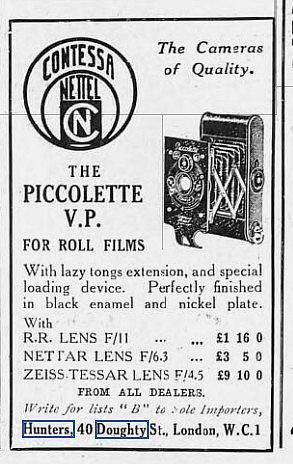 |
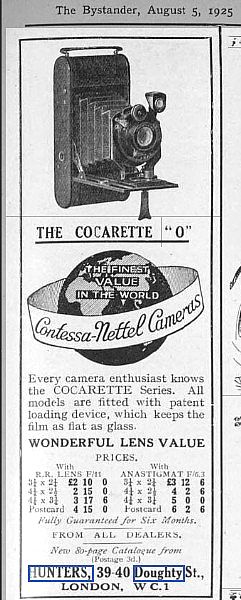 |
Robin Selby recalls that his grandfather (Arthur Blackburn) joined R.F.Hunter's London wholesale distribution business in 1923 (Amateur Photographer magazine reported the date as 1924, see here) and eventually became Chairman. That the distribution business at 40 Doughty Street came into existence in 1923 is seemingly confirmed by the 1922 electoral return showing that Bob and Maud Hunter had, by then, accommodation in London, at 65 Chancery Lane, though their main ‘abode’ was still at No.3 Rockcliffe Dale Road, Buxton. However, by 1923 their address had become No.40 Doughty Street, London, WC1, meaning that their formal move from Buxton can be traced to between 1922 and 1923. Alongside are two R.F.Hunter advertisements that appeared in The Bystander magazine, the extreme left hand on June 24th 1925 and the other on August 5th 1925. Below left, is shown an advertisement that appeared in Amateur Photographer magazine on 5th February 1927. Notice that the August 1925 and February 1927 adverts both mention No.39 Doughty Street as well as No.40. This time period seems to be the only occasion that No.39 appears within Hunter advertisements. It represents a small mystery, since archive records show that No.39 was occupied by three tenant families (one on each level) during that period, none of whom are understood to have had any connection with R.F.Hunter. All that can be surmised is that perhaps Bob and Maud Hunter temporarily rented the basement of No 39 for extra storage during this period, and put 39-40 Doughty Street on their advertising to look more impressive. In these advertisements, R.F.Hunter ("Hunters" as they called themselves at that time) are acting as photographic equipment distributors not retailers; the adverts state "From All Dealers" or "From Dealers Everywhere". A 1931 R.F.Hunter catalogue owned by Robin Selby contains 88 pages and helpfully tells readers that No.40 Doughty Street is a 1d (old penny) bus or tram ride away from King's Cross, St Pancras or Euston railway stations. |
||
|
On 14th November 1927 the Directors of R.F.Hunter Ltd (some 8 months before R.F.Hunter Ltd acquired the business at 40 Doughty Street) were: Robert Forgie Hunter, resident
at 40 Doughty Street, London, WC2 |
||||
 |
All three show Contessa Nettel cameras, a range designed and manufactured by Dr.August Nagel. Based upon text in Brian Wallen's Photography Notes: Paraphrasing text
on the Camera Collector site: The above has relevance to the assisgnment of the Doughty Street business into R.F.Hunter Ltd (June 1928, see above). The assignment deed transferred all of the Doughty Street business into R.F.Hunter Ltd except for the contract between Bob Hunter and Zeiss Ikon Aktiengesellschaft of Dresden, which brings us back to Dr.Nagel. This contract was clearly fundamental to R.F.Hunter Ltd's success, and perhaps nearly as important as the later distribution agreement with RolleiWerke. The assignment deed was witnessed by Dorothy Amesbury, invoice clerk, probably aged just 24. She was born Dorothy Amesbury and married Thomas Brown in 1935. Robin Selby initially found difficulty understanding R.F.Hunter's business strategy of running retail businesses in both Buxton and Cheltenham while also setting up a distribution business in London - "it sounds like a brilliant way of losing money". However, with all these early advertisements offering cameras by Dr.Nagel, its possible to see some sense in this business strategy, viz: If Bob Hunter saw his future in camera distribution rather than retail, and sought to act as UK distributor for Nagel cameras, it may have made him more credible to Dr.Nagel if Bob Hunter was able to say "I’ve got a chain of photographic equipment shops and I’m branching into wholesaling". |
|||
|
'Celfix' projection screens were always a major product line from by R.F.Hunter, and Robin Selby believes that it was Arthur Blackburn who may have coined the name 'Celfix', a word that became synonymous with R.F.Hunter's headquarters when they moved to Gray's Inn Road. Robin explains that the name 'Celfix' is a conflation of ‘Self’ and ‘Fix’, intending to convey the idea of Celfix screens being 'easy to set up for use', via their advertised self erecting 'automatic' mechanism. Arthur Blackburn used this same name for his private houses; he named two of his houses 'Celfix'. In the British Journal Photographic Almanac (BJPA) for 1948, the R.F.Hunter advertisement says 'Celfix' is a Registered Trade Mark, Patented throughout the world. British Patent Nos. 345, 925; 376, 385; 416, 403; 456, 133. Two of these patents, taken out by Robert Forgie Hunter and Robin's grandfather, Arthur Blackburn, can be downloaded by clicking the links, 15th Sept. 1930 and 9th May 1934. They describe the screen support structure mechanism. Further demonstrating the links between R.F.Hunter and the Nagel brothers, Hugo Nagel, who had many photographic patents to his name, is named alongside Bob Hunter and Arthur Blackburn in the 15th September 1930 patent. |
||||
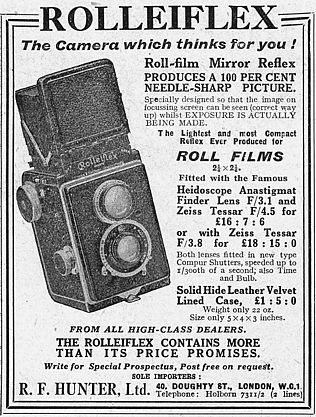 |
Possibly helped by R.F.Hunter already acting as distrbutors for Dr.Nagel's cameras, it was about this time that Paul Franke is believed to have had a conversation with Robert Forgie Hunter along the lines of "if I make these (meaning the Rollei TLR camera) can you sell them?" Arthur Blackburn was then instrumental in negotiating the agreement with Paul Franke whereby R.F.Hunter became the UK distributor for what was to become the world famous Rollei Twin Lens Reflex (TLR) 12 on 120 roll film camera range. By the end of 1929 the first Rolleiflex cameras had been manufactured. Orders from the UK, and around the world, were far greater than Paul Franke and Reinhold Heidecke ever anticipated, and by 1930 Rollei had back orders for 8,000 cameras !
This picture is of Paul Franke in August 1949, aged 61. He died on 18th March 1950 and was succeeeded at Rollei by his son, Horst. Reinhold Heidecke died in 1960, almost ten years to the day after Paul Franke died. The picture of Paul Franke is taken from Ian Parker's book, "Rollei TLR; The History". When this website author met Ian on 6th April 2004, Ian was aged 77 and ran 'The Jersey Photographic Museum' from the Hotel de France, Jersey. Quoting from Ian Parker's book (page 126): "His (Paul's) visits to the English importers (R.F.Hunter) were eagerly awaited by some of the staff. He brought chocolates from Germany for some of the typists, gave a monetary reward to someone in the service (repair) department (perhaps Frank Sampson, see below) and rewarded the Commissionaire on the main entrance at Gray's Inn Road. |
|||
|
Above is a R.F.Hunter advertisement from Amateur Photographer magazine for 10th September 1930 when the company was operating from their premises at 40 Doughty Street, London, WC1. No.40 Doughty Street still exists today (2019) and is an imposing Georgian multi-storey town house, that would have adequately housed the fledgling R.F.Hunter camera and projection screen distribution business. |
||||
 Above and to the right are garden photographs at the house of Paul and Ella Franke. In the photograph above are Arthur Blackburn with Paul's wife, Ella. Paul Franke is at the extreme right of the picture. These pictures probably date to the 1930s. |
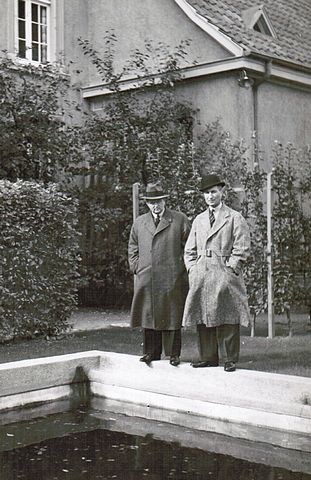 |
 |
Alongside is an advertisement for the automated and patented 'Celfix' cine projection screen, taken from an Amateur Photographer magazine dated 7th October 1931. This would have been 10 years after R.F.Hunter's formation and 8 years after Arthur Blackburn joined R.F.Hunter. The home ciné film format in use at the time of the CELFIX being introduced, would have been 16mm, brought out by Kodak in 1923. This was expensive for amateur (home) use, but this screen meant that R.F.Hunter was well placed to take advantage of the arrival of the new, lower cost, 8mm home ciné format, introduced by Kodak in 1932 (USA) and which appeared in the UK in Spring 1933 (ref: The Home Photographer and Snapshots, advert p77, April 1933). Robin Selby suggests that since the company brand name was generated from the mechanism for erecting a projection screen, rather than from some aspect of a camera, the projection screen business was an important source of R.F.Hunter's revenue. Initially, Hunters only produced the fabric part of the screen but subsequently they acquired the manufacturer of the metal supporting parts also. The move from Doughty Street to 'Celfix House' at 51 Gray's Inn Road, London, WC1, seemingly occurred between October 1931 and 1932 (Refs: see alongside; advert from AP 7th October 1931; telephone directory entry supplied by Robin Selby; 1933 RF Hunter catalogue owned by Robin Selby). Its presumed this occurred as a consequence of increased turnover. Certainly, the Rollei camera became an instant success, which would have added to the firms camera distribution activities (including the Purma camera and its accessories from around 1937). The company address expanded to 51-53 Gray's Inn Road by the time of the RF Hunter advertisement pages in the 1955 BJPA, which contained information supplied prior to December 1954. However, Photoguide magazine shows that expansion into the No. 51-53 address didn't formally occur until between March and April 1955. The company's progress was interrupted by WW2 (1939-45), which curtailed many civilian phoptographic activities, though the armed forces applied photography extensively for enemy surveillance. Nonetheless, the availability of German Rollei cameras was immediately lost and life in London, both domestic and commercial, became disturbed by air raids. Hence, Robin Selby recalls that Jim Selby (Robin's father and son-in-law of Arthur Blackburn) put up £4,000 to purchase the Manor House in Leighton Buzzard, where the firm of R.F.Hunter Ltd worked during WW2. Arthur Blackburn ran the firm alone during WW2. Purchase of Manor House was underway by October 1940 and completed by the end of the year (Ref: e-mail from Robin Selby, 18th June 2020). Apart from 'Celfix' cine screens, the range of Hunter screens in 1948 included 'Roller' screens, 'Self-Recta' and 'Raybrite'. |
|||||||
|
The two sons of Robert Forgie Hunter and Maud May Clayton i.e. William Clayton and Cyril Robert, were educated at Sutton Valance in Surrey. William Clayton Hunter went up to St John's in Cambridge, where he graduated before joining Dartington Hall in September 1932 as a geography teacher. Dartington Hall, at Totnes, Devon, was an experimental 'free thinking' educational establishment that operated until around 1980. William was keen to introduce cine film use, particularly to create documentary, advertising and classroom films for teaching pruposes. William's son, Andy Hunter, has documented his father's notable involvement in the development of the Film Unit at Dartington Hall and his 'paper' can be downloaded by clicking the link here. Dartington Hall still exists (2019) as a venue for many interests, including cinema, concerts and exhibitions. William left Dartington Hall towards the end of 1941 when he decided it was impossible for him to remain in civilian life. He volunteered for the RAF and became part of the RAF Photographic Interpretation Unit at RAF Medmenham, based at Danesfield House near Medmenham, in Buckinghamshire. Sadly, William Hunter died in 1943. He is buried in the war graves section of Halton church yard. |
||||||||
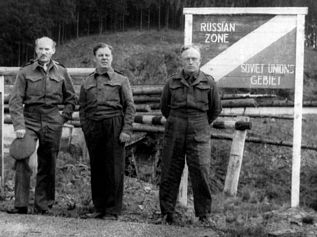 |
Cyril Robert Hunter was with
the Army throughout WW2 and saw service in Italy. He left with
the rank of Major. A family anecdote talks of Cyril being on
the last boat out of Dunkirk, but that hasn't been checked. He
was certainly in Italy and Austria later on. He then joined the family firm and learned German, possibly by contact with Franke and Heidecke of Rollei manufacturing fame. While Cyril was in Italy, his wife Polly (Pauline; née Church) and their daughters (Ursula and Claire) lived with Robert Forgie and Ella in Scotland. Cyril and Polly also had a son, named William (Bill) Hunter, born 1947, and a younger daughter, named Susan. |
|||||||
|
Robert Forgie's wife, Maud May, died in 1937 and subsequently (1st April 1939) Robert Forgie married Ella Louise Hofmann (born 13th January 1909), who had been the Private Secretary to Arthur Blackburn at R.F.Hunter Ltd from 31st July 1936. Ella was born in Poplar, a London district near Isle of Dogs, coincidentally where the Selby family originated. Her father and mother were George Hofmann (a baker) and Gertrude. In 1901 George Hofmann was listed as a German subject, aged 20, a journeyman baker boarding at 94 Chatsworth Rd, Hackney. Robin Selby recalls that Ella had very little accent and he never guessed her parents were German. There must have been some problem for Ella's German parents at the outbreak of WW2, as the London Gazette of 25th July 1941 shows that Gertrude Hofmann had to be 're-admitted' to British Nationality. Robert Forgie and Ella went on to have three children, named Ian, Louise and Frances. During the early part of WW2, Robert and Ella lived in a house called 'Heightley' (confirmed from the 1939 Register; also by Frances Fallmyr; née Hunter), along Dunstable Road (a section of the Roman Watling Street) at 167 Blackhorse Lane in the village of Redbourn, near Harpenden in Hertfordshire. Robin Selby has carried out some research on the house known as 'Heightley' (Heightley has been demolished and modern houses now occupy the site) and believes it was built prior to WW1 (certainly prior to 1922). Robin's mother Rene lived with Robert and Ella for maybe 6 months and Robin retains memories of the house having expensive decorations and a large, splendid, garden, that required Robert and Ella to employ a gardener. Frances Fallmyr, daughter to Bob Hunter from his marriage to Ella Hofmann, says "Heightley was indeed a large house, and my parents were helped by a resident housekeeper and her husband, who managed the garden. He also served as butler. Whilst my parents still lived there, at the start of the war, my father Bob volunteered for the Home Guard, and the fact that they had a telephone in those days was very useful for communication!" Later during WW2, Robert and Ella moved to the village of Dalry, in Kirkcudbrightshire, to a house called 'Egremont' (19 miles from Newton Stewart). The three children, Ian, Louise and Frances, were born there. Their move to Scotland left Arthur Blackburn to run the firm alone. Arthur told his grandson Robin that the firm scraped a living during WW2 by repairing RAF photographic equipment at Leighton Buzzard. |
||||||||

|
|
|
||||||
|
R.F.Hunter Ltd was 'only' ever a wholesale phoptographic equipment trading company. Except for running a camera repair workshop (see below, right) their only involvement with equipment manufacture was projection screens. The 1945 BJPA records R.F.Hunter still entirely located at The Manor, Leighton Buzzard, but with the advertising 'rider' saying they were "of Celfix House, Gray's Inn Road". By 1946, the company of R.F.Hunter returned to Celfix House at 51-53, Gray's Inn Road, London WC1 (see below, left), though screen manufacture continued at Leighton Buzzard, managed by a Mr. Baker. |
|||||

|
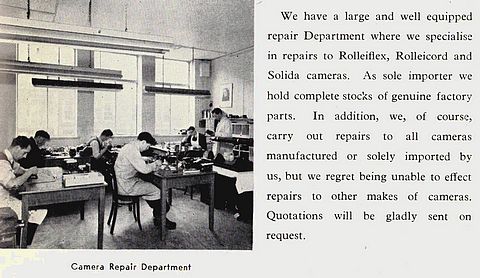

|
||||
|
Pauline Ranger told how, while her father, Frank Sampson, worked at Hunter’s, he used to repair Antony Armstrong Jones’ cameras and the family received Christmas cards from him most years while they lived in England. In about 1963, Frank Sampson repaired a camera that belonged to someone from New Zealand. Whilst he was repairing the camera the man said "Have you ever thought about coming to New Zealand to live?" Frank replied "No", and the response back to Frank was "Well, if you would like to, there is a job for you at Agfa New Zealand". So, in 1964 the family (including Pauline) moved to New Zealand and Frank Sampson then worked for Agfa, repairing cameras. He went on to repair X-Ray processing machines, newspaper printing machines, photocopiers and other similar that Pauline doesn't know details about. Frank used to travel all over New Zealand repairing machines and also applied his skills on some of the Pacific Islands. He retired when he was aged 65 and passed away when he was 88. Pauline, and her husband Ron Ranger, still (2017) have Frank's collection of cameras, including 2 Rolleiflex – one of which he brought over to New Zealand from England when the family emigrated. |
|||||
|
On 13th July 1948 the Directors
of R.F.Hunter Ltd were: Cine Screens Ltd was clearly the company responsible for manufacturing and marketing the CELFIX (and other) projection screens, but it is difficult to know what Rolleiflex Ltd was for. Sydney Oram, a major shareholder in 1928, died in 1943. His shares are believed to have been predominantly sold to Bob Hunter or Arthur Blackburn, perhaps around the time of his death. The family retained just 11% by 1959. At that time 93% of the shareholding was divided: Hunter = 64% |
|||||
|
By the late 1940's Donald Paterson and Cyril Hunter were firm friends. Donald Paterson had qualified as a Dentist and then as a Lawyer. His connection with R.F.Hunter Ltd was as an inventor of (amateur) home developing and printing equipment, which he marketed through R.F.Hunter under the brand name of Paterson Products. Donald had a small workshop in the same premises in 160-164 Gray's Inn Road where Hunter's camera repairs were carried out. Donald employed his own toolmaker, by which means he kept ownership of all the tools and dies for the injection moulding processes. The rest of Donald's production was subcontracted. The BJPA for 1950 includes the first advertisement for Paterson equipment, being their first film developing tank. Andy Hunter recalls there was a fire at the Leighton Buzzard screen factory around 1955 (see below, 3 photographs by Arthur 'Blackie' Blackburn) and Robin Selby has film showing the smoking ruins of the factory and also construction of the new factory, with his grandmother (Ann Blackburn) laying the new foundation stone. A new warehouse was constructed around the same time. |
|||||
|
|
|
|
|
Jim Selby with his wife Rene, outside the new warehouse at Leighton Buzzard |
|
|
 |
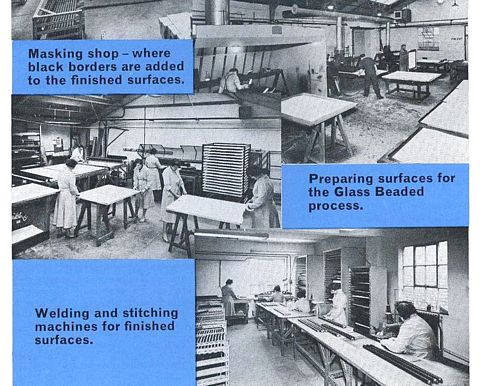 |
|

|
|
|
|
The war with Germany meant the loss of Rolleiflex and Rolleicord camera imports to the UK and even though the war ended 8th May 1945, the Rollei range of cameras weren't advertised again by R.F.Hunter until 1952 when the BJPA included a picture of the latest Rolleiflex and also mentioned the new Rolleicord III. Accompanying text within the BJPA advert warned that the cameras were not (at that time) freely available for sale in the UK. It explained that the UK Board of Trade had imposed import restrictions post-WW2. Information researched from elsewhere reveals that any imported camera could not be valued higher than £5.10s (£5.50p) including freight and insurance charges (CIF) into a UK port. This excluded all Rollei cameras by a wide margin. In 1955, even the 'budget' Rolleicord V retailed for near £70, while the price of a Rolleiflex exceeded £100. These restrictions weren't entirely lifted until 1960 (but see below). The range was then the Rolleiflex 2.8E2 (£120-£140), the Rolleiflex 3.5F (£110-£120), The Tele-Rolleiflex (£170-£185), the Rolleiflex T (£75-£90) and the 'Baby' 4x4 Rolleiflex taking 127 size film (£46). There was also a Rolleicord Va (£48; note the unexpected price reduction from 1955). By the late 1950s the UK Board of Trade was making exceptions to their import restriction, for "professional photographers, scientific, medical and essential Industrial users". Robin Selby has acquired a 1959/60 R.F.Hunter catalogue which he recognises from its cover as one he used to avidly read some 60 years previous. It was issued on 11th May 1959 and consists of 80 pages, with a note on the front cover saying that the R.F.Hunter Export Department is at 164 Gray’s Inn Road. The first 18 pages of the catalogue are devoted to Rollei cameras and their accessories. There is an accompanying 8-page leaflet of ‘Rollei News’ printed in Germany and a note stating: "The Board of Trade will consider granting special Import Licences for Rollei cameras where it can be shown that the camera is required for essential purposes. In this category fall Professional Photographers, Scientific, Medical and essential Industrial users. Applications must be made direct to the Board of Trade but your dealer will be only too pleased to give you full particulars". The price of Rollei equipment had increased considerably compared to 1939, when a Rolleiflex with F3.5 Tessar had cost just £31.25p. Robin Selby conjectures whether R.F.Hunter decided to take advantage that potential Rollei purchasers could only be businesses or institutions, and thus charged premium prices. Whatever the reason, it successfully assisted the company's finances just prior to its flotation on the stock exchange. Other cameras within the catalogue, of more modest price, were the German made Franka and Solida range of cameras, with the Japanese Petri range also being distributed by the mid 1960s, the latter perhaps showing an attempt to diversify. The Purma camera seems no longer to have been marketed after 1951 and the Gilbert box camera (see below) also seems to disappear from the catalogue by 1960. |
||
|
In the post-war years, while waiting the recommencement of supplies of Rollei cameras, R.F.Hunter acted as distributor to other UK produced photographic equipment plus, of course, their expanding range of projection screens. By the 1950s, 35mm colour slide film (especially) was in increasing usage, which meant the demand for projection screens was rapidly increasing. The other product range that was rapidly expanding throughout the 1950s were those devised by Donald Paterson. By 1952 there were two Paterson developing tanks, the "35" and the "Major", plus a simple 'hold up to the eye' 35mm slide viewer. This range increased year on year to soon cover every darkroom requirement. |
||
|
In the early 1950’s Margaret lived at 49 Fitzroy Road NW1, next door to Geoffrey and Theodora Gilbert, who lived at No.47. The Gilbert's had twin girls (born in the late 1940’s?). Geoffrey Gilbert was a photographer and on at least one occasion worked on advertising shots in Andy's house. The one Andy especially remembers was for furniture polish, which used lots of tricks with reflecting layers to enhance the impression of shininess. Geoffrey Gilbert designed a simple box style camera around this time, which was called the 'Gilbert' and was subsequently distributed by R.F.Hunter. It has its first appearance within the R.F.Hunter BJPA advertisements in 1954. David Gardner, a member of the PCCGB, has estimated that a total of 8,000 (though perhaps up to 10,000) were manufactured over a 3-4 year period. Geoffrey Gilbert later (1955) moved to a house on Haverstock Hill at the junction with Parkhill Road, where he had a garden with over 1000 different species of plants, especially alpines. Andy reports that 'Google street view' shows that this house has since been replaced by a block of flats. |
||
.jpg) |
||
|
Robert Forgie Hunter died in 1955 and in 1960 R.F.Hunter was 'floated' on the London Stock Market underwritten by Old Broad Street Securities, becoming R.F.Hunter (Holdings) Ltd. Jim Selby, Arthur Blackburn's son-in-law and an accountant, had (by 1962; Ref: see top letterhead) joined the company as Finance Director.
In 1964, Margaret Mary Hunter (widow of William Clayton Hunter) retired. In 1966, Johnsons of Hendon purchased R.F.Hunter (Holdings) Ltd. Stanley Houghton was the chairman of Johnsons at that time. Cyril Hunter and Arthur Blackburn were retained in their previous posts for a short period and a new distribution agreement was signed with Rollei Werke in 1966. Robin Selby recalls his grandfather, Arthur Blackburn, and Stanley Houghton travelled together to Germany to get the new agreement with Rollei, which was fundamental to the deal between Johnsons and Hunters going ahead. Apparently Jim Selby remarked that making the travel arrangements, by train, for two gentlemen of advanced years (Arthur Blackburn was born in 1896) posed considerable problems. Arthur Blackburn retired on 31st December 1966 (see pictures below). Hestair took over Johnsons of Hendon in 1972 and its believed that Stanley Houghton 'resigned' the same morning, though his exit was less dignified than Arthur Blakburn's. In an anecdote from Andy Hunter, told him by his mother, Stanley was 'brutally dismissed' from his post as Chairman, following the Hestair take over. He was quite simply asked to leave the keys, both to his flat in Baker Street and of his company car, on his desk and was then escorted from the office. He was told his personal effects and a settlement cheque would be sent in due course. Thereafter, Johnsons underwent major restructuring. They abandoned chemical production in 1974 and the valuable Hendon Way site was sold off and became (part of ?) the Brent Cross Shopping Centre, "the London home of IKEA" as Andy Hunter describes it. Hestair also sold off R.F.Hunter (Holdings) Ltd in 1972, surprisingly to Rollei, and this prompted Jim Selby to resign. The Hunter logo, as subsequently used by the 'Hunter Division of Rollei (UK) Ltd', can be seen to the right, further down this page. German directors were appointed on 12th July 1972, though the year is obscure. Jim Selby and Cyril Hunter resigned on 29th March 1972. On 12th November 1981 the Board decided that the company could not, by reason of its liabilities, continue its business, and that it should be wound up. The liquidator was appointed on the same day. From the liquidator's final report of 22nd July 1985, it appears that total proved creditors amounted to £1,706,000, of which £1,591,000 was owed to Rollei-Werke. The latter debt consisted of loans made by Rollei-Werke, and probably also camera stocks for which payment had not been made. Assets totalled £576,000 and, after various payments, creditors only received 20.68p in the pound. Andy Hunter muses that Patterson Products must have simply gone their own way. Then, in 1975, Donald Paterson drowned trying to rescue a youngster while on holiday in Scotland. |
||
| Below are photographs taken at a formal Dinner in December 1966 on the occasion of Arthur Blackburn's retirement. The meal was held at the Connaught Rooms, in London. | ||
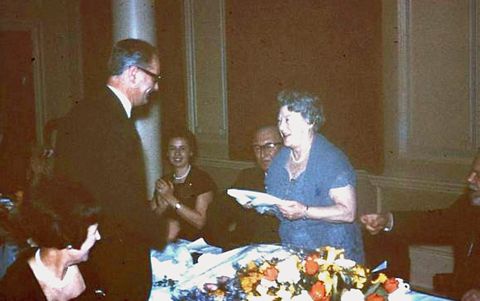 Above: Ann Blackburn, Arthur's wife and Robin Selby's grandmother, is being presented with a gift which Robin believes was a silver tray. Arthur Blackburn is sitting alongside her. At the extreme right can be seen the bearded face of Cyril Hunter. |
Cyril Hunter making a speech, with Ann and Arthur Blackburn alongside. |
|
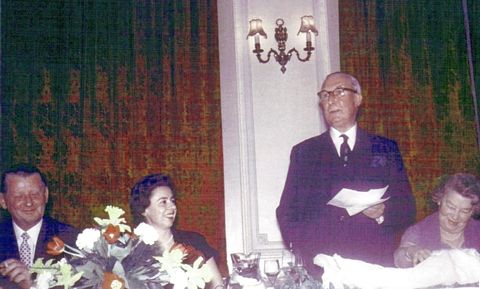 Arthur Blackburn giving his speech. His wife, Ann, is to the right. On the left of the picture are Horst Franke (son of Paul Franke) and his wife Jutta. The 'Rollei 35' camera came out in 1966. Horst presented one to Arthur Blackburn when he stayed with them at 'Celfix' (the private home of the Blackburns) to attend the retirement dinner. |
Stanley Houghton making a speech. Stanley Houghton was the chairman of Johnsons of Hendon at the time when Johnsons took over R.F.Hunter (Holdings) Ltd in 1966. |
|
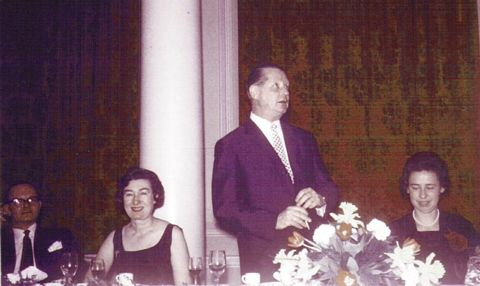 Horst Franke is giving a speech. His wife Jutta is on the right of the picture. Jim Selby and his wife Rene are on the left of the picture. |
 Left to Right, back row: Cyril Hunter, Mr Binstead, Arthur Blackburn (Blackie), Donald Paterson, Stanley Houghton, and 'Rossite' man (Rossite was a hand colouring system for black & white prints, marketed for about 10 years, to 1950). Left to Right, front row: Unknown, Miss Stevens, Ann Blackburn, Maggie Hunter (Andy's mother), Polly Hunter (Cyril's wife). |
|
| Below are some later photographs of the Franke family | ||
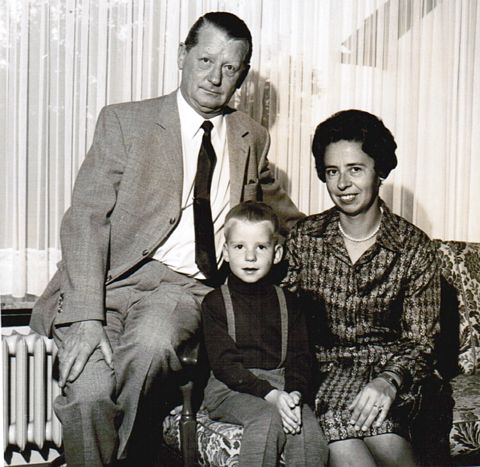 Horst and Jutta Franke, with their son Kai, August 1969. |
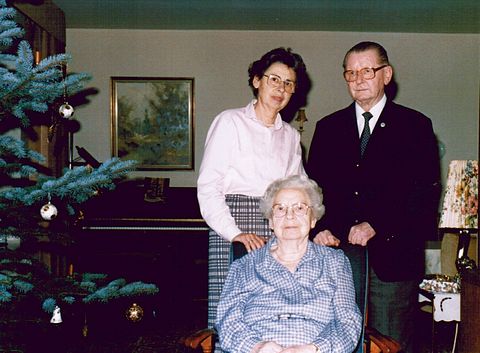 Taken in December 1988. Horst and Jutta Franke with Jutta's mother. |
|
|
Footnote: The parents of Margaret Mary Hunter (née Reid), Andy's mother, were church people and Grandfather Reid was a Vicar and Prebendry of the Cathedral in Exeter. William Clayton Hunter and Margaret Mary Reid were married in Exeter Cathedral in 1936 in "rather a grand ceremony". Andy continues "My parents were both on the staff of Dartington Hall School, Totnes, where they met. Andy himself was born at St. Mary Arches Rectory in Exeter in 1938. After William Clayton Hunter (Andy's father) died in February 1943, Margaret Hunter returned to her parents home in Exeter, where she and Andy lived for a year. A daughter, Joanna was born to Margaret in May 1943. Perhaps the above connections with Exeter explain why Robert Forgie Hunter is sometimes believed to have lived there in 1943. |
||
|
|
|
|
|
The situation with
Rollei Werke in 1969 The managing director Horst Franke retains his 31.66 per cent share in the firm, with co-director Dr.Heinrich Peesel holding 3.33 per cent. Mrs Ella Franke, widow of Rollei founder Paul Franke, will continue to hold a five per cent interest. Cyril Hunter, head of UK Rollei distributors R.F.Hunter, commented that the revised financial footing of the German company will make no difference to its marketing strategy in the UK." The situation with
Rollei Werke in 1979 By this time, despite being the most desirable of cameras during the 1950s and 1960s, the bulky and somewhat inflexible fixed-lens TLR Rollei design had become out-dated. Enthusiastic amateurs, and certainly professionals, wanted the versatility of an interchangeable lens system with through the lens viewing and metering. For most subjects, the ubiquitous Japanese made 35mm SLR had become 'king', though the rangefinder Leica system still appealed to many where money was no object and rangefinder focussing and noiseless operation were paramount. Professionals seeking ultimate quality for studio or location work, used roll film cameras like the Hasselblad or larger. Andy Hunter takes up the story. In 1981, Franke & Heidecke went bankrupt. A quote from the internet reads "After that, the name went through similar indignities that befell rival Vöigtlander as the company was bought and sold several times, though unlike Vöigtlannder it managed to continue production. Wikipedia concludes: "Rolleiflex medium format cameras continued to be produced by DHW Fototechnik up to 2014—a company founded by former Franke & Heidecke employees. DHW Fototechnik announced two new Rolleiflex cameras and a new electronic shutter for Photokina 2012. The company filed for insolvency in 2014 and was dissolved in April 2015, ending any further production. The factory production equipment and remaining stocks of parts were auctioned off in late April 2015. A smaller company was created again with former DHW Fototechnik employees under the name DW Photo at the same location. DW Photo focuses on producing the Rolleiflex Hy6 mod2 medium format SLR camera (digital & film), servicing existing cameras, including providing firmware and hardware upgrades. In the story below, the writer (in December 1979) compares Rollei to the failing British car manufacturing organisation, British Leyland, which became BL Ltd before being sold, first to BMW and then to a short-lived management buyout. |
||
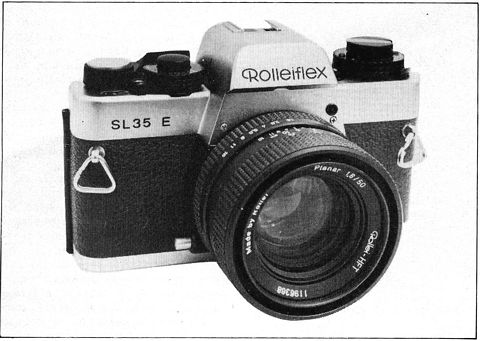 |
 Hunter Division, Rollei (UK) Ltd. Denington Estate, Wellingborough, Northants, NN8 2RG |
|
|
Here is the story of a company. A company whose workers raised the cost of their wages until, while the company was willing to pay them, the world was not. Since the world was their real paymaster, the company began to shrink. Cold blooded bankers lent the Company money. At least the bankers thought of themselves as being cold blooded, but they were not. If they had been, they would never have lent the money which kept the company from the bankruptcy courts. They made the loans because they were of the same blood as the workers of the company and they were proud to share that blood. They and the workers knew that the company had a heritage and that the skills they had inherited from their fathers and grandfathers could not be taken up quickly by mere foreigners. The sales force also knew that the company had a great name and that its products could only be matched by a very few. The sales management were arrogant with the same belief and they treated their dealers with scant concern for their well-being, bringing out a wealth of new models when the old were not yet cleared from the showrooms. It all had to end somewhere and apart from the managing director's ulcers, the first to suffer were the workers. Making it clear The dear old 'Rollei', as it was known throughout photographic circles, finally gave its affectionate name to the company itself several years ago. By that time the company was in deep financial difficulties. Even its home market in Germany was swamped by the Japanese invasion. In fact, the history of the company could almost be written as a film script, and only the names would need to be changed to make it a topical 'In Depth' study of British Leyland (oh, it too has suffered a change of name, it is now BL Ltd). Only the part of the BL story which tells of the government intervention would have to be changed. In the German case this activity was taken up by the banks. The subsequent story of the Rollei company might even tell the story of the future of BL. Rollei went into a loose partnership with its conquerers and set up a factory in Singapore. There are a lot of unemployed ex-Rollei workers in Germany and a lot of very employed citizens of Singapore doing the work in their place. It is uncanny to notice resemblance after resemblance in the two cases. The bland unconcern of the sales management in the two cases. The singular lack of after-sales back-up. The charging of the press with 'an unhelpful attitude' when their shortcomings were pointed out, at first politely and with a later degree of anger and point as the criticism was unheeded and even resented. Sticky period It was not that the cameras were poor quality. They were not. In fact they were of uniformly high quality. On the whole they tended to be a bit behind the opposition in features and a long way behind in value for money. But Rollei have had on the market for some time a camera which makes the Hasselblad seem Iike an out-of-date tin can and there at least we are puzzled, for it should have wiped the floor with the opposition. One is stunned when first you hear the price, but when you add up all the extras needed (and bought), for the Hasselblad to bring it up to the Rollei standard, then by contrast the Rollei is a good buy and a far better camera. Maybe it is yet another blow-back due to the old Rollei sales techniques. But concerning the SL35E Encouragingly, the reviewer concludes his test of the Rollei SL35 E by saying "We were quite surprised to note that we parted with the camera with some sadness when the test period was over." |
||
|
|
|
|
|
John Hunter was a printer compositor and may well have been interested in photography, as were William and Charles. Bob Hunter, as the above story relates, made photographic retail and distribution his life-long career, and one of his earliest photographic businesses was at 9 Cavendish Circle, Buxton, Derbyshire. The picture at the lower right (below) is of John Hunter's son, Alexander Wylie Hunter, in his WW1 army uniform. On the back of the postcard print (portion enlarged, see left) is the printed text "Photo by Hunters, 9 Cavendish Circus, Buxton". The handwritten note is by Karen's mother. It may be that this photograph was taken by Alexander's Uncle Bob Hunter at his Buxton premises, though Bob Hunter served in the 1st WW so would not always have been at the family business. Sadly, Alexander died in the War (in 1915), presumably not long after his photograph was taken. Return to Top of Page. |
||
 William Hunter |
_cr.jpg) William Hunter (circled); masonic bowling tournament (c.1910) |
|
 Charles Hunter |
 John Hunter |
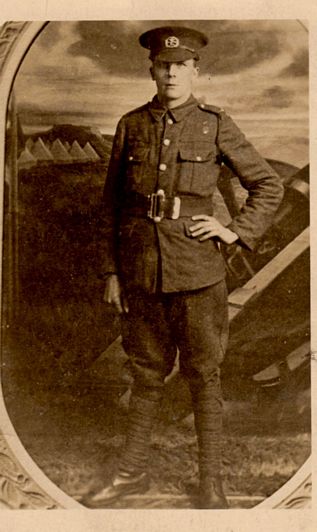 John's son, Alexander Wylie Hunter |
|
|
||
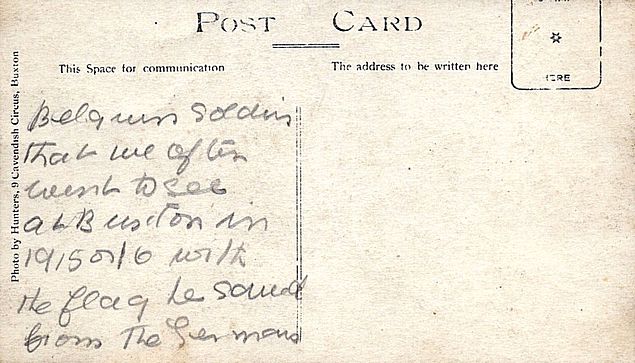
 Robin
Selby's mother stayed with the Franke family for six months in
1936. She had some interesting insights into middle class German
family life – they had a seamstress stay in the house for
some weeks while she made new clothes for them.
Robin
Selby's mother stayed with the Franke family for six months in
1936. She had some interesting insights into middle class German
family life – they had a seamstress stay in the house for
some weeks while she made new clothes for them.
.jpg)
 In
1962 the Rollei TLR range consisted of the 2.8F, the 3.5F, the
'T', the Tele and Wide Angle Rolleiflexes, the 4x4 'Baby'Rollei
(12 on 127 film) and the automatic Rolleimagic. About this time
the Rolleicord Va became the Vb.
In
1962 the Rollei TLR range consisted of the 2.8F, the 3.5F, the
'T', the Tele and Wide Angle Rolleiflexes, the 4x4 'Baby'Rollei
(12 on 127 film) and the automatic Rolleimagic. About this time
the Rolleicord Va became the Vb.